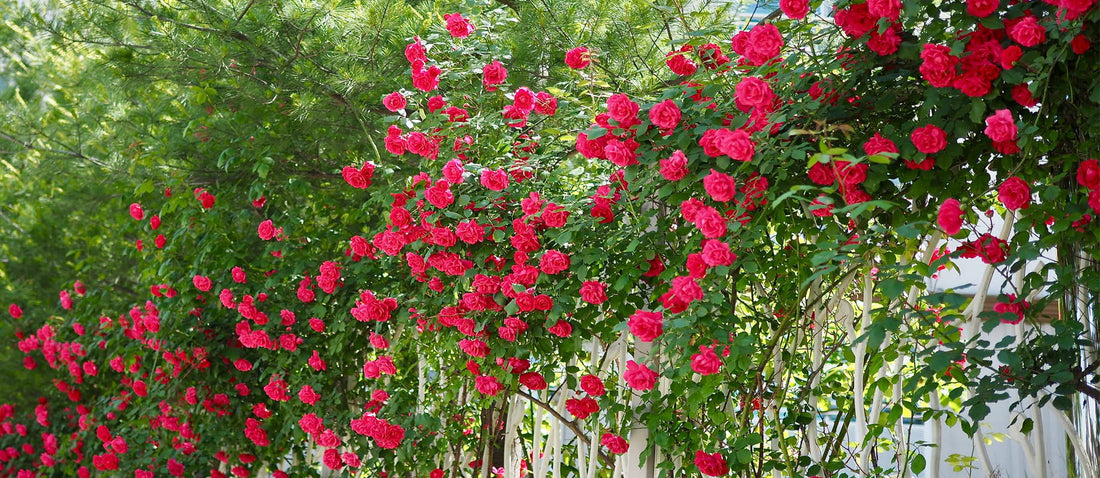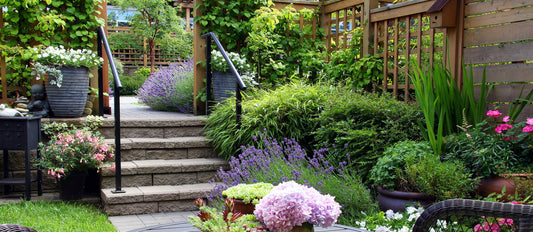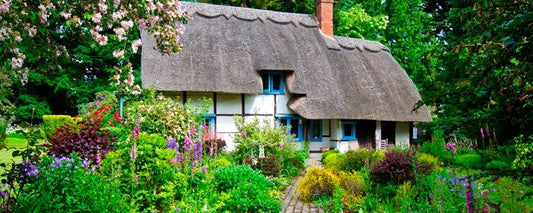When choosing and purchasing a climbing rose, almost everyone has a romantic vision of a sweet smelling cascade of flowers enriching their garden. Taking note of the following will help make this dream a reality.
Which variety?
- A rose that is a climbing variety will be indicated by having 'clg' (for 'climbing') in front of its botanical name. There are a large number to choose from, Rambler roses being among the most popular because of their good growing characteristics. These roses flower after the first year, appearing from horizontal or trained branches.
- The 'tea hybrids' are another good choice of climber, although these need to be trained horizontally to stop them becoming 'leggy'. This will result in even growth all over the plant and not just at the top.
- A third popular variety of climber is the perpetual flowering rose. They often flower in bunches and, if you cut them back to the first five-fingered leaf after flowering, you will be treated to a second period of abundant flowering. If you leave the left-off flowers on the plant, the second flowering period will be diminished. However, perpetual flowering roses are very generous and, in this case, they will treat you to lovely red rose hips instead, which look very decorative in the autumn and winter months.
Which colour?
Roses come in just about every colour, from snow white to almost black-red and from almost translucent yellow to bright orange. There are even blue varieties, although these will never flower really blue, but will have more of a lavender shade. If the final colour is important to you, be wary of roses bought from 'cut-price' garden centres or supermarkets. These are rarely colourfast.
Where to plant?
With climbing roses you are spoilt for choice. They can grow up a trellis or an old hedge, over an unsightly wall, up a pergola or into an old tree, as an obelisk in the middle of your garden or even as a flowering garland. The key conditions for success are always (and this goes for all roses) that the rose is planted in:
- Well-fertilised, loose soil
- A sunny and aerated, though sheltered spot
Further, it is always important to: - Fertilise regularly with a low nitrogen, high magnesium fertiliser.
- Water regularly (especially when temperatures rise above 22°C and in the first growing season)
- Check regularly for pests and diseases.
Roses climbing up a trellis or over an old hedge
Choosing a variety that is self-clinging or only needs a bit of guidance to wind through a trellis or hedge will save you a lot of work cutting and training. Planting two different colours, and letting them mix randomly, can produce a lovely and lively effect. Place the trellis or hedge in a not very windy or shady spot.
Roses climbing up a wall
Practically every wall is suitable for climbing roses but avoid very sheltered, south facing walls as these might become too hot, causing your rose to scorch or dry out. In these locations, perhaps vines might be more successful. Rambler roses are suitable for covering a wall although you will have to lead and tie the rose up. Only choose 4 or 5 main branches and attach a trellis on to the wall, leaving 2 cm between the trellis and the wall for air circulation. Plant the rose at about 30cm from the wall. Nearer to the wall the ground will be too dry. Water generously! In the summer after the rose has flowered it can be cut back. If there are more than 5 main branches, the oldest ones can be cut back as far as possible. Cut the other branches back to the desired height, just above a developing shoot.
Climbing roses on a pergola, old tree, as obelisk or garland
If you want a roof of roses for your pergola, you need to plant several roses on both sides of the pergola. The young plants will also need leading and tying up. You will see good results in just one year and in only three years the rosy roof should have reached its full height. The same applies to roses in trees or obelisks. If you rejuvenate the top in time, you can be assured of a waterfall of flowers. For an extraordinary effect try leading your rose along a chain that links different parts of the garden together. Stretch the chain in such a way that it forms natural curves. Prevent damaged branches from rubbing on the metal by winding the chain with 1cm thick rope. Plant a few roses next to the point where your chain starts. After one year the branches will just reach the chain. Twist the young flexible branches around the chain and secure them if necessary. With some patience and careful cutting you can soon have a beautiful flowering garland running through your garden.
Cutting perpetual flowering roses is done after the first flowering period. Cut the left-off flowers back to the first five-fingered leaf. At this spot you can expect a new flowering shoot to develop. The real cutting is done in March. Select 4 or 5 sturdy main shoots, young ones if possible. Cut all side branches back to 2 to 3 eyes (the spots where new shoots are developing). With a garland you only cut the branches that do not produce flowers anymore.
Wild shoots
As most roses are grafted onto a wild rootstock, fast growing wild shoots can suddenly develop. They are easily recognisable by their many thorns. It is important to cut such a shoot back as far and as soon as possible as these shoots use lots of energy and multiply rapidly, eventually destroying your 'real' rose.
Fertilising
Your climbing rose will grow very rapidly and will provide you with a wealth of flowers. To generate the required energy for this you should fertilise the plant twice a year, in March and July, with special organic rose fertiliser or an artificial fertiliser. Bonemeal can be used as an alternative but be aware that this is a slower acting fertiliser although its effect is longer lasting. Be careful not to feed your plant with artificial fertiliser in autumn as this could cause fungal diseases on the new shoots. Organic fertiliser will be essential at that time since, during the winter, the nutrients can slowly be rained into the ground and absorbed.
Protection from frost and disease
The graft, a kind of lump just above the roots, is very sensitive to frost. Put an extra layer of soil, straw or mulch around this spot, to protect the plant from freezing. When cutting, always use a clean, sharp pair of secateurs. Clean them after cutting each plant to prevent diseases from spreading through cutting. Remove all dead leaves around the roots of the plant in autumn as these can cause fungal diseases.




